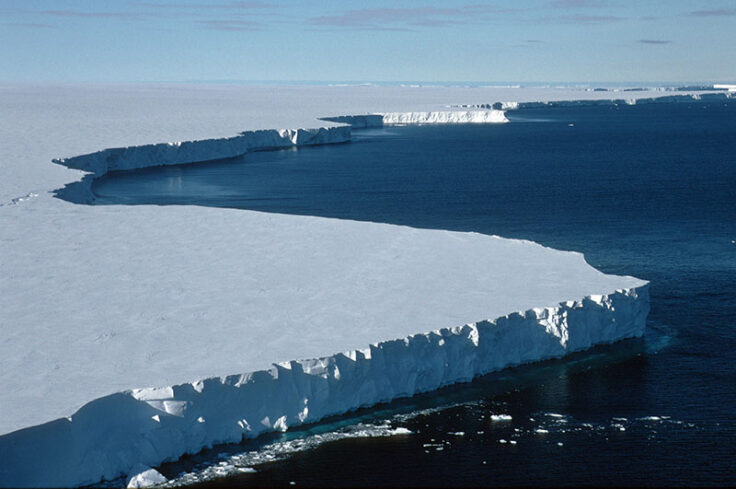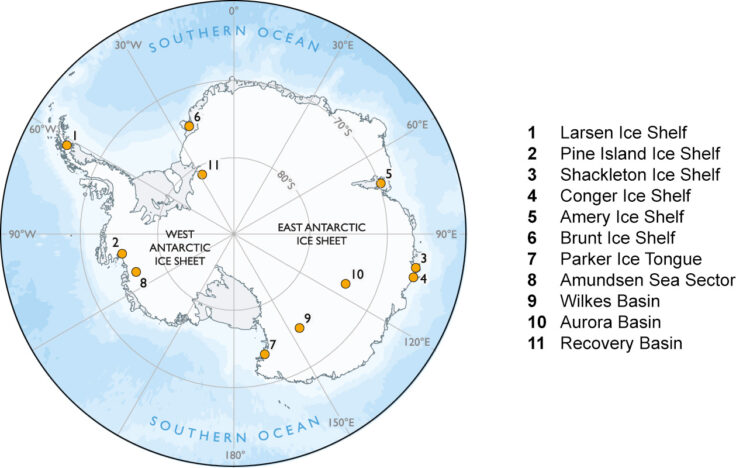Concern is rising about tipping points in the Antarctic region (Armstrong et al., 2022). Recent heatwaves, changes in the Southern Ocean, and a reduction in the extent of Antarctic sea ice suggest that we may be closing in on tipping points. These are defined as a critical threshold beyond which a system reorganises in a self-sustaining and/or irreversible manner. Once these tipping points are crossed major changes will occur, or begin to occur, in Antarctica. Alongside impacts on global sea level and climate, these changes will have consequences for ecosystems, including in important ecosystem services such as fisheries and carbon regulation.
Triggers for Antarctic tipping points
Changes have recently been observed in Antarctica and the Southern Ocean that may trigger tipping points. Melt from the Antarctic ice sheet, and from sea-ice loss, has slowed down parts of the Southern Ocean circulation by 30% since the 1990s (Gunn et al., 2023). Alongside this slowing, new minima in Antarctic sea-ice cover occurred both in 2022 (Turner et al., 2022) and then again in 2023, together with unprecedented Antarctic heatwave events (Wille et al., 2023). These Antarctic heat extremes, and Southern Ocean circulation and sea-ice cover changes, are not necessarily tipping points. However, on the back of global warming, these type of changes are important. At some threshold, they will push Antarctic tipping elements, including vulnerable ice shelves and glaciers, across one or more tipping points.
Antarctic ice shelf tipping points
Ice shelves are floating tongues of ice formed where glaciers flow into the ocean. They play a stabilising role at the edge of the Antarctic ice sheet, slowing down the flow of ice into the ocean. Ice shelves can pass a tipping point when local temperature thresholds are crossed, causing the ice shelves to thin and float in places where they were previously held in place (or pinned) by contact with the seabed. Melting at the surface also thins and weakens ice shelves, and in some cases water on the surface fills up cracks in the ice and can then cause large areas to disintegrate catastrophically. Where these types of processes act together, an ice shelf can partially or fully collapse.
Recent regional Southern Ocean warming patterns, and associated changes in circulation, have led to an increase in thinning and unpinning of ice shelves (Miles and Bingham, 2023). While the air temperatures over many ice shelves have been too cold to permit water to gather in cracks, this is beginning to change. Several ice shelves, including the major Larsen, Pine Island, and Shackleton Ice Shelves may collapse due to water in cracks within the next 70 or so years (Gilbert and Kittle, 2021). The recent collapse of the Conger Ice Shelf in March 2022 coincided with a heatwave driven by a river of warm air, around +35°C above average, which flowed across east Antarctica (Lhermite et al., 2023). Strong storms, driven by other unusual flows of warm air, were also largely responsible for partial losses from the Amery and Brunt Ice Shelves in 2019 and 2021 (Francis et al., 2022). A reduction in Antarctic sea ice and associated regional warming is also thought to have been largely responsible for the collapse of the Parker Ice Tongue in 2021 (Gomez-Fell, 2022). Although the behaviour of ice shelves varies across Antarctica, once collapsed, recovery of the ice shelf is not possible until the ocean cools sufficiently. This in unlikely to occur for at least some centuries.

Antarctic glacier and ice sheet tipping points
Inland from the ice shelves are the Antarctic glaciers, which are themselves contained within the huge West and East Antarctic Ice Sheets. Large parts of both of these vast ice sheets are resting on bedrock that slopes inland into deep basins well below the current sea level. This bedrock configuration makes these glaciers and ice sheets potentially vulnerable to crossing tipping points. As the stabilising effects of ice shelves are lost, glaciers in these deep basins can then flow faster; the front of the ice retreats into gradually deeper water, the ice flow speeds up and glacier retreat becomes more rapid and self-sustaining. This affects the rate of global sea-level rise because more ice is lost from the Antarctic continent and enters the global ocean.
The Amundsen Sea sector of the West Antarctic Ice Sheet contains 3-4m of potential global sea-level rise and is currently the biggest contributor from Antarctica to the rise of global sea level. Observations of ice change over recent years, together with modelling studies, indicate that irreversible retreat might already be underway in this region (Pattyn and Morlighem, 2020). In some parts of the East Antarctic Ice Sheet, another tipping point behaviour is also possible: the loss of ice shelves could create tall and unstable ice cliffs that collapse under their own weight, exposing taller cliffs further inland and again leading to a rapid self-reinforcing retreat (DeConto et al., 2021). However, this particular behaviour has not been widely observed in Antarctica and the importance of this process is still being assessed (e.g. Edwards et al., 2019).
Once the ice shelves have gone, tipping points for the glaciers they hold back may be crossed at between 1-3°C in West Antarctica and 2-6°C in East Antarctica (Figure 1; DeConto et al., 2021; Armstrong et al., 2022). Part of this large uncertainty is due to scientists puzzling over the potential importance of the ice-cliff collapse behaviour. If all this ice entered the global ocean, which would likely take some thousands of years, this could eventually produce up to 24 metres of global sea-level rise.

Ecological tipping points
Antarctic marine biota are highly adapted to their environment, thus changes in ice, or in the Southern Ocean, have the potential to trigger complex multidirectional effects on Antarctic ecosystems (Atkinson et al., 2021). Whilst determining thresholds for ecological tipping points is challenging due to ecosystem complexity (Heinze et al., 2021), sea-ice or ice-shelf loss is likely to strongly affect phytoplankton blooms. Alterations to this primary phytoplankton productivity will have consequences for the biological carbon pump, which currently removes 50-60Gt of carbon every year, around 10% of this to the deep ocean. Without this carbon pump, atmospheric CO2 would already be around 200ppm higher than it is at present.
The crucial Southern Ocean carbon pump depends on the seasonal downward pumping of lipids (oily organic compounds), itself driven by the vertical migration of lipid-rich zooplankton into the deep ocean during winter. There, the zooplankton use up these lipids for energy and expire CO2 as a result, so injecting carbon into these deep waters. This process is fundamentally dependent upon the zooplankton building up lipid reserves in spring and summer, and so relies on their life-cycles coinciding with their principal food source, dense phytoplankton blooms. The loss of sea ice will alter the timing of blooms, making them earlier and less intense. Cold temperatures prevent zooplankton developing any quicker, and so the precise nature of these sea-ice changes really matter. This resultant mismatch between phytoplankton and zooplankton may arrest the carbon pump to the deep ocean. Regime shift dynamics in primary productivity and resultant reconfigurations of the food web, both locally and globally, will also have major consequences for Southern Ocean fisheries (Robinson, 2022).

Outlook
Antarctica is changing now as a result of global warming. There is clear potential for irreversible and self-sustaining changes in the ice shelves and glaciers of the Antarctic ice sheet. Indeed, it may be that we are already witnessing the beginning of these changes, in the recent ice-shelf losses and rapid retreat of glaciers in West Antarctica. Crossing Antarctic tipping points will have huge implications for global sea level, and for future carbon emissions and fisheries. The global impacts highlight the urgency for global action, by all nations together, to cut carbon emissions and maintain Antarctica as a stable, ice-covered continent.
References
Armstrong et al. 2022, doi.org/10.1126/science.abn7950
Atkinson et al. 2021, doi.org/10.1111/gcb.16009
DeConto et al. 2021. doi: 10.1038/s41586-021-03427-0;
Edwards et al. 2019. doi: 10.1038/s41586-019-0901-4;
Francis et al., 2022, doi.org/10.1029/2021JD036424
Gilbert and Kittle, 2021, doi.org/10.1029/2020GL091733
Gomez-Fell et al., 2022 doi.org/10.1029/2021GL096156
Gunn et al. 2023, doi.org/10.1038/s41558-023-01667-8
Heinze et al. 2021, doi.org/10.1073/pnas.2008478118
Lhermitte et al., 2023, doi.org/10.5194/egusphere-egu23-16400
Miles & Bingham, 2023, doi.org/10.5194/egusphere-egu23-7200
Pattyn & Morlighem, 2020, doi.org/10.1126/science.aaz5487
Robinson, 2022, doi.org/10.1111/gcb.16309
Rintoul et al. 2018, doi.org/10.1038/s41586-018-0173-4
Turner et al. 2022 doi:10.1029/2022GL098904
Wille et al., 2023 doi.org/10.5194/egusphere-egu23-8107
Authors
Dr Louise Sime1, Dr Rachel Cavanagh1, Prof Jane Francis1, Prof Tim Naish2, Dr Oliver Marsh1, Prof Geraint Tarling1, Dr C. Rosie Williams1
1British Antarctic Survey, 2University of Wellington (NZ)